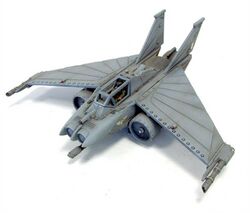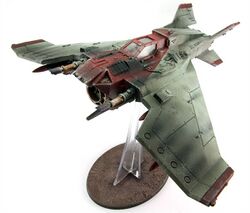Lightning Fighter


The Lightning is the Imperial Navy's premiere air superiority fighter, with agility unmatched by any other Imperial flyer thanks to its distinctive forward-swept wings. Though its primary weapons are a long-barreled autocannon and twin-linked lascannons for engaging enemy aircraft, it can be fitted with one of several varieties of missiles and bombs to specialize in anti-armor, anti-infantry, or anti-air operations.
Lightning 'Strike'
The 'Strike' variant Lightning is the same airframe, but with more missiles or bombs instead of the underslung autocannon.
Voss Pattern
In December 2012, Forge World retired the old Lightning model and released a more advanced-looking "Voss Pattern" Lightning Strike Fighter. It features slightly sturdier-looking wings, a beefier, single engine intake, and a more streamlined nose (especially compared to the goofy "headlights" of the original). It uses plasma engines, allowing it to not bother with a big ass (literally) rocket and therefore should also go much faster due to the difference in weight as well as simply having far more powerful engines which also allow for it to function just as capably in space as in atmosphere. As usual, Voss-pattern whatever is made of common sense (wonder why they haven't been met with exterminatus yet). Funnily enough, despite its sensible costume, the Voss Pattern is actually a worse design than the original Lightning. It’s wings have been moved forward, which consequently has moves its center of lift forward, while the majority of the airframe has stayed the same. This would likely move the center of lift ahead of the center of mass, leading to an incredibly unstable craft with a tendency to flip itself ass-forwards and spin out of control. Of course, this is 40k we’re talking about, so all of these concerns can be explained with the words ”space magic”.
Real Life
Forward-swept wings have been tried on real experimental aircraft, and they do confer some benefits, like enhanced maneuverability, improved airflow and the possibility of a more compact airframe. It also comes with the drawbacks of instability (though modern avionics can make the minute corrections required to keep the aircraft steady) and a risk of the wings twisting themselves to pieces at high speeds. These issues meant that it took about 50 years from the idea's conception before prototype high-performance fighter aircraft with forward-swept wings could be built (the Grumman X-29 in 1984, and the Sukhoi Su-47 in 1997, and both of those ended up being scrapped anyway). For comparison, it took the Adeptus Mechanicus over five hundred years to fix these issues in the Lightning, and they didn't even come up with the idea themselves -- they had to find the STC first. On the flipside, the people who were trying to fix them were probably being shot at by their own colleagues, so it's rather notable they managed to fix them at all. On the other hand, Imperial aircraft doubtless work using gravitational and inertia manipulation along with the commonly mentioned vectored thrust. So, the shape of the wings is irrelevant.